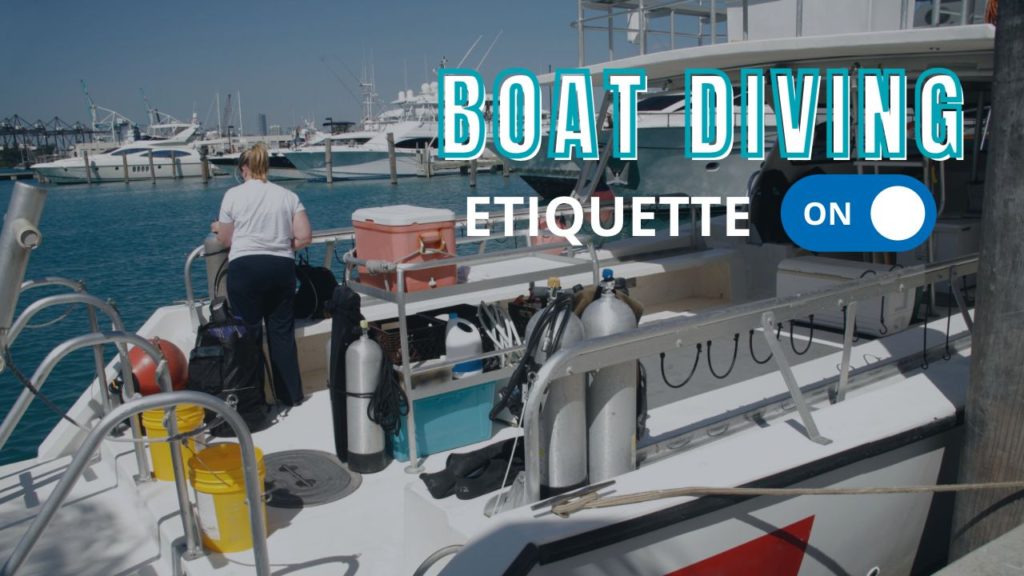I learned to dive many years ago (before dirt I think). My instructor at the time, Scott, insisted on our final two checkout dives being off of a boat in the ocean – because this was Wrightsville Beach, NC. North Carolina wreck diving was my goal and he wanted me to be prepared for it, so I was lectured on boat diving etiquette before I ever set foot on a dive boat.
Over the years, I’ve progressed in my diving (Hypoxic Trimix, CCR) and in my preferences of boats. Most of my diving now is on 6-packs (maximum of 6 divers) with other divers at or near my experience level. Recently, I’ve been on a few dives on some larger boats (12-18 divers) with a mixture of divers, some who are just beginning their adventures to others that are more advanced. Many of these divers are only now trying out NC wreck diving. One thing that is obvious is that many of them did not get the introduction to boat diving etiquette that I did. I thought I’d sit down today and share some of the knowledge that I’ve picked up over the years.
Communicate with the dive center or charter company
First and foremost is: call/message/email and ask questions. Whatever your question is, just reach out to the shop or charter company. Want to know if your rental gear will be on the boat or if you have to pick it up yourself? Call. You don’t want to be underway and find out your rental tanks aren’t on the boat and are still at the shop waiting for you to pick them up. Want to know if the boat will be providing a 3-course meal? Call. You don’t want to be out on the water for 8+ hours with nothing to eat between dives. You’ll see this mantra throughout. Why? Because boats operating in the Caribbean, for example, will be very different from a 6-pack running out of Hatteras, NC.
Planning
Next, planning for a boat trip. What gear should you bring? Diving from a boat isn’t like going to a local lake, river, spring, or quarry where you’re only limited by the amount of gear your vehicle can haul. Space on a boat is limited and you should only bring what you need for the dive you’re doing. Think hard about what you bring. Do you really need that scooter if you’re diving a small in-shore tug? Do you need that lionfish gear if you’re diving shallow spots that don’t normally have lionfish? Do you need to bring that briefcase sized hard case with your laptop for a half-day trip, or could you wait and edit your videos and pictures on shore? Do you need to bring a bag of spare regs, parts, and hoses along with your super-sized toolbox? For a dive boat, most people normally have one dive bag worth of gear and a dry bag that will fit under the bench. Some boats have specific space for cameras and specific storage spots for deco/bailout bottles. Call ahead of time and find out.
If you aren’t familiar with the wrecks or reefs you’re going to be diving, which might influence what gear you want to bring, just call and ask. All good charter operators will have emergency gear on board and most of them will have a well-stocked toolbox and spare gear. The bottom line is that there is no need to bring gear that the boat has or that you won’t use/need. You need to find out how much space there is on the boat as well as what equipment the boat has on board.
Don’t forget to ask about food and water! If you’re used to diving boats in the Caribbean, then this may be a foreign concept. Most charters on the US East Coast will provide water and nothing more. You need to find out what they do provide and plan accordingly. Water, snacks, and something even more substantial if it’s a full-day charter.
Lastly, make sure to know what time to be at the dock and if there are parking restrictions, then be there on time. Is 7:30 am the time to be at the dock, or is it when the boat plans on leaving? Don’t be the person that shows up late and holds up the boat and don’t be the person who gets back to the dock to discover their car has been towed.
On the boat…
Once you’re on the boat, get your gear set up. In many vacation destinations with “valet” diving, someone else may be carrying your gear to the boat and setting it up. From my experience, every dive operator I’ve ever used from West Palm Beach to Cape Hatteras expects you to carry your own gear on board and set it up yourself. Often these boats will be passing through rough inlets and into an ocean that is a bit “bouncy”. Trying to get a BC on a tank is no fun on a rolling boat – get it all done before you leave the dock and stow everything out of the way.
How I like to unpack on a boat
My personal preference is to unpack:
- My wetsuit, fins, etc.
- Put my gear bag under the bench
- Stack gear on top of it in the opposite order that I will need it.
- So, bottom to top we have:
- Empty gear bag, fins (with boots in the foot pockets)
- Pocket shorts
- Wetsuit
- So, bottom to top we have:
Something to note
There is a key phrase here that some of you may have missed. That phrase was “under the bench”. I have recently seen several divers using large, semi-hard sided bags that are so big they would be checked luggage at the airport. If your gear bag or bin can’t fit under the bench where your gear is, then it shouldn’t be on the boat. Huge gear bags, or lots of bags that won’t fit under the bench, take up valuable space on an already crowded boat. Other people won’t be as careful with your gear as you are, so leaving it in the way is asking for trouble.
WHERE DO YOU STORE THINGS THAT NEED TO STAY DRY?
Next, where is the other stuff you’ve brought going to go? I often bring spare batteries (for lights, dive computers, and the CCR) that the boats don’t have. I also might bring a towel and maybe some dry clothes to change into. These items need to go somewhere dry and out of everyone’s way. Just ask the crew where the best spot is.
Stow and secure
Finally, before the boat gets underway, make sure that all of your gear is stowed and secure. Make sure that tanks are bungeed in so that they don’t fall, for example. Many of the dives I do are technical, so I bring decompression or bail out tanks – boats will normally have specific spots for these that will keep them safe. As the saying goes, if your tank falls and breaks someone else’s mask, they are still going diving, but you may not be.
Underway and Diving
I think the main thing to know at this point is to listen to crew instructions. Especially listen to the boat safety briefing – there may be rules about staying seated when going through an inlet or in rough seas, and I’m sure that there will be important information about the head and the best “fish feeding” spots.
Once you’re at or very close to the dive spot, begin gearing up, but stay out of the way of the crew. The crew needs to get the boat tied in and prepped for your dive. Typically, once the boat is tied in and prepped, the captain or one of the crew will give a site briefing and discuss any specific procedures. For example, what to do if you can’t find the anchor at the end of your dive – listen to them!
One procedure that I see ignored far too often off the NC coast is to not hang around at the surface. Often, we have current, and hanging around on the surface, especially not paying attention to the tag line trailing behind the boat, can get you into trouble quickly. Work with gear on the boat or under the water is what most captains will say. You do not want to ruin a dive by jumping in and floating away because you were too busy fixing how a piece of gear is attached.
Be aware of time
Although no captain or crew is going to rush you into the water before you’re ready, be cognizant of time. Half-day charters in particular may be on a schedule. Even a full-day charter may be trying to get back before dark or before dead low tide at the inlet. Problems can certainly hold you up, but if everyone else is off the boat 5 minutes before you’re even thinking about standing up, then the crew is starting to wonder if you’re mentally ready for the dive (typically divers who gear up slowly are nervous about the dive). At a minimum, the captain is starting to think about the difference in surface intervals between you and the other divers.
If you know that you are slow at gearing up, start gearing up sooner. When I switched from OC to CCR and had to do a pre-breathe, I adjusted when I started gearing up so that I could still get in the water quickly.
Heading in
Heading Home is the easy part. Personally, I try to get all of my gear packed up and stowed while the crew is getting the boat ready to leave the dive site, but as long as your gear is stowed and out of the way, most operators don’t mind if you wait to pack your gear bag back at the dock.
Tip your mates
Once you are back at the dock, get your gear off of the boat as quickly as possible. The crew has to clean the boat at a minimum and may need to prep it for another charter. And don’t forget to tip the mates! Every charter I’ve ever been on mentions this. I’ve heard some people say $10/tank but I personally opt for something closer to 20% of the charter cost. Tipping is a personal choice and may only be expected in the US and Caribbean. Just be prepared.
A note on cancellations
One final thought is that you should always read the charter policy on refunds. Reputable charters will refund your money if they cancel for some reason (e.g. weather or mechanical issues). Most charters will also have a policy about what happens if you cancel. That policy typically means that if you cancel within some time frame (1 week, 2 days, etc.) then you still have to pay for the spot if it can’t be filled. If an individual, or a dive shop, is responsible for the charter and you cancel on them at the last minute, then the individual or shop may have to pay for the spot even if it can’t be filled – don’t be the guy that doesn’t cover your spot after canceling because you may not be invited back.
By Jay King


